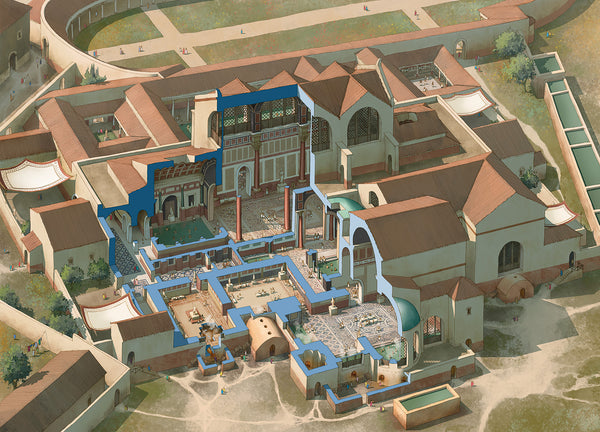Phoenicians and the Making of the Mediterranean - Review
By Owain Williams
Last year, we featured several book reviews for books that explore regions and cultures beyond the typical ancient triad of Egypt, Greece, and Rome. We explored ancient India, Persia, Africa more generally, and the Mayans. This time, we are going back to the Mediterranean to discuss the Phoenicians.
The Phoenicians’ influence on the various societies around the Mediterranean in the Iron Age has long been acknowledged, as discussed, for example, in the late María Eugenia Aubet’s The Phoenicians and the West: Politics, Colonies and Trade. After all, they are the ones who, notably, introduced the alphabet to the Greeks. However, as López-Ruiz argues, the true extent of the Phoenicians’ influence has been overlooked and misrepresented in favour of a Hellenocentric model. Indeed, the very existence of the Phoenicians as a cultural group has been called into question by so-called Phoenicosceptics. As such, in Phoenicians and the Making of the Mediterranean, Carolina López-Ruiz seeks to offer a corrective to that Hellenocentric model, emphasizing the Phoenicians’ role in the creation of a “pan-Mediterranean “class” of urban, literate, and sophisticated elites, whose affinities were articulated through common visual, cultural, and economic modes” (p. 1). These modes are all part of what López-Ruiz terms the ‘orientalizing kit’ – “a package of orientalizing goods and cultural capital” (p. 3) – and, consequently, the book’s focus is on the eighth and seventh centuries BC, the period when this ‘kit’ spread throughout the Mediterranean.

Before embarking on a comprehensive, wide-ranging survey of the different regions of the Mediterranean, López-Ruiz first discusses the assumptions and arguments that underpin the Hellenocentric model. Firstly, the nature of Phoenician activity in the Mediterranean, so often summed up as that of merchants and traders, is re-examined in light of modern archaeological research. “In the popular imagination,” López-Ruiz writes, “the Phoenicians are merchants and sailors, not farmers” (p. 38), and their colonies, besides the more well-known example of Carthage, are little more than emporia, trading posts. This image is comprehensively deconstructed and the pieces rebuilt into a more nuanced picture, one in which the Phoenicians were not just traders, but settlers, farmers, and craftspeople, interacting and intermingling with local communities. Secondly, López-Ruiz advocates for a ‘Mediterranean’ rather than a ‘Classical’ (i.e., Greek) model with which we can fully explore the developments in the Mediterranean, exploring how there was a previous assumption of the agency of the Greeks in the spread of cultural elements, such as the alphabet and orientalizing art, throughout the Mediterranean, with Greek agents being thought responsible. Thirdly and finally, Lopez-Ruiz explains what the orientalizing kit is composed of and what she will be looking for in the various regions studied in the rest of the book as evidence of Phoenician influence. Once the core premise of the book has been fully explained, López-Ruiz then takes readers on a region-by-region survey of different parts of the Mediterranean, going from west to east, presenting the various types of evidence for Phoenician presence and influence on local cultures, such as the Iberians, Etruscans, and Greeks. There are plenty of interesting points that many readers may not have been aware of. For example, despite all my reading about Sparta in the past, I never knew that there was possibly a Phoenician community near the sanctuary of Artemis Orthia in Sparta, catering to local desires for votive ivories and terracotta masks, and Artemis’ epithet may even derive from a Semitic name!
Phoenicians and the Making of the Mediterranean is an impressive display of scholarship that passionately argues for a reconsideration of our own assumptions and reassessment of the evidence to offer a more comprehensive understanding of the Iron Age Mediterranean. López-Ruiz never assumes that orientalizing works were the result of Phoenician presence, instead preferring the term ‘Levantine’, and constructing an argument from the evidence as to why the Phoenicians were the Levantine culture responsible for the presence of these developments. Despite the care López-Ruiz takes in constructing the argument for the role of the Phoenicians, there were moments where the roles of other cultures, such as the North Syrians, were potentially overlooked. Of course, López-Ruiz is concerned with the presence of the Phoenicians, but more acknowledgement of others’ influence would be welcome. That said, the evidence for the presence of North Syrians in, for example, the Aegean, is still far less than that for the Phoenicians. The book’s scope also meant that there were moments where arguments were not presented as fully as they could have been, such as the idea that the Greek polis developed under the influence of the Phoenicians, whether through the presence of Phoenicians within Greek communities or direct Greek exposure to Phoenician administrative systems in the Levantine city states. Similarly, there were important pieces of scholarship, typically those tangential to the Phoenicians but still related, that were overlooked. For example, López-Ruiz connects the traditions of sacred prostitution at Corinth and in Phoenicia as evidence for potential connections between the two, yet there is no acknowledgement of Stephanie Bundin’s study of sacred prostitution in both ancient Greece and the Near East, which strongly concludes that “There were no sacred prostitutes in the ancient Near East” (2008, p. 47).
However, these criticisms (and the occasional editing error) are very minor and do not detract from what this book accomplishes – a challenging deconstruction of previous assumptions and a thoroughly convincing advocation for the Phoenicians’ rightful place in the history of the ancient Mediterranean.
References:
M.E. Aubet, The Phoenicians and the West: Politics, Colonies and Trade, Second Edition (Cambridge: Cambridge University Press, 2001).
S.L. Bundin, The Myth of Sacred Prostitution (Cambridge: Cambridge University Press, 2008).
Phoenicians and the Making of the Mediterranean is available in paperback from Harvard University Press for £20.95 or US$24.95.

